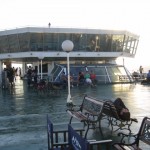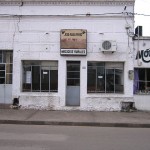Saying hi . . . from Uruguay! :)
Greetings from the beautiful capitol city of Uruguay . . . Montevideo!
With a population of more than 1.7 million, Montevideo still feels like a small town. People are friendly, caring, sweet people. Not detached and disinterested or too busy to say hello–even to a stranger.
Just for example, recently I was waiting with my son in line for a taxi. That´s how they do it here in many cases–you wait in line. It was raining and the young man ahead of us struck up conversation with us. He asked where we were going. We told him. He said, “I am going right by there. Come and go with me in my cab.” And we did. I find this friendliness and caring attitude is typical of Uruguayans.
The architecture here is decidedly European. And so are the people. With my European ancestry, no one on the street can tell I am not a local unless I speak. I don´t stand out.
As one travel writer has said of Uruguay, it is more European than Europe!
Part of this city is known as Ciudad Vieja, or Old City. It is the historical area of Montevideo. It is situated right on the Atlantic Ocean, but over the years, the area deteriorated into a slum. The old architecture is grand and beautiful. But the buildings were, and many still are, in serious disrepair. A lot of undesirable folks had taken up residence there. Although I feel safe in the daytime, I would be a bit apprehensive there at night. But even that may be changing.
Ciudad Vieja where much restoration has taken place.
The city fathers decided to restore the old area. As part of that program they offer a tax benefit to those who buy and refurbish the old buildings. So if you are into refurbishing real estate, and you like tax breaks, then come on down!
It is interesting to wander through the city in the daytime, looking at the old, ornate architecture, and imagine what it was like in years past–the people who laughed and cried and lived and died there. What secrets the old city could tell us!
Here is one of the streets in the restored area.
It is surprising that that part of the city fell into such disrepair since waterfront areas usually are the most expensive.
Aside from the Ciudad Vieja, the type of petty crime that exists in Argentina is minimal in Uruguay. I have seen an unattended cart in the local grocery store with a purse sitting in it, a car left parked next to a sidewalk, running, with the key in the ignition, and other signs that locals are not worried about crime. Things I doubt if you would see in Argentina–and probably should not do here for that matter! But people are not worried enough to be really cautious. I walk around downtown alone, safely, at any time of night.
Throughout Montevideo, all day, you will see the recyclers driving their horses and wagons through the traffic-filled streets where they search through the trash for treasure. These are what you might call professional dumpster-divers!
Comparing Uruguay to Argentina
Argentina is becoming more and more expensive all the time. The last economic crash in Argentina was in 2001. Argentines claim that this happens to them about every ten years. There is now fear among Argentines that another crash may be in the making. Some people think that that fear is what is moving prices skyward—i.e., that it is a matter of perception. The Argentines experienced hyperinflation leading up to the 2001 crash, with prices changing every day. I don´t mean that when they woke up the next morning the prices were higher, I mean they would go up during the day. That is hyperinflation.
As Doug Casey, of The Casey Report, who invests and lives part of the year in Argentina, says, Argentina has the stupidest government in the world. But many Argentines believe that these crises are not the result of stupidity, but that they are engineered by the bankers and super wealthy who then move in and grab up the spoils. Many savvy Argentines are too smart to get caught in the trap, if it is true. Their money is in Swiss francs or Uruguay banks.
Several Argentines have told me NOT to bank in Argentina but open an account in Uruguay for any “serious money” since Uruguay is considered the Switzerland of South America, with strict bank secrecy. (Addendum comment: The bank secrecy was changed with the 2009 OECD meeting. See Banking in Uruguay for details. Secrecy in Uruguay still applies to most of the world–but not for U. S. Citizens. Addendum two: And as of May, 2012, Uruguay has yielded to pressure to open accounts of Argentine clients to the Argentina government.) I happened to mention that advice to a lawyer in Buenos Aires. He looked alarmed and said, “Don´t ever say that to ANYONE! That is illegal!” And then he proceeded to tell me how to do it and said he could give me contact information for Uruguay banks!
I used to criticize how things are done in Latin America. I now think that in some circumstances, the savvy people learn how to survive and prosper in the situation they are in—the others get fleeced.
I don’t think this should keep anyone from living in Argentina. It has a lot going for it, and if you protect the buying power of your cash, perhaps you could snatch up bargains yourself when Argentina has another crisis.
Uruguay is not considered as exciting as Argentina. There are no ski slopes. In fact, as far as I know it never snows anywhere in Uruguay. There are no mountains. No real sightseeing attractions that I know of except for the beaches–which are fantastic. As one writer expresses the difference, Argentina vibrates. Uruguay, on the other hand, is laid back–tranquil. However, Uruguay is also more stable in many ways–particularly economically.
We explored all the way up the Atlantic coast to Chuy, on the border of Brazil. I sent a list of real estate buys from that area, at the time, to those of you that expressed an interest. The prices there are incredibly low. On real estate and everything else! I hear that Brazil is a good place to buy real estate. Houses are available there as low as $25,000 in good areas. Since Chuy is smack on the border with Brazil, that might influence the prices.
There are several small beach towns on the eastern seaboard that would be lovely for retirees who do not need to depend on business or work for survival, although seasonal businesses do very well during the season. Many close down during the off season.
La Paloma is one of these lovely beach towns. It is a small beach resort with an interesting lighthouse. Considerably south of La Paloma is a beautiful beach town only 20 minutes from Punta del Este, and about one hour´s drive from Montevideo, one and a half hour´s ride by bus.
Punta del Este is the beachgoer´s mecca of Uruguay, frequented by visitors from Europe and some North Americans as well as latinos. At Punta, if you didn´t know you were in Uruguay you might think you were on Miami Beach. There are fancy restaurants, glistening high rise apartments and hotels and, of course, the beaches. I was there in January and everything was exceedingly crowded–and exceedingly expensive. It is beautiful, though, if you like Miami Beach type cities. As with most of the coastal towns, the economy depends on tourism, which lasts from December to March with some tourists coming as late as May or June. After that most of these places turn into ghost towns except for a few year-round residents. In January, Piriápolis was busy, crowded, and we had problems getting a room. When we did, it was expensive. But in February there was no problem getting lodging close to the beach and prices had dropped.
However, the ghost town effect may not be permanent. There are many North Americans retiring and moving into the Piriápolis area in particular, as well as Punta and points further north toward Brazil. For a retiree who wants to be near the beach, and still close enough to Montevideo for doctor visits and other things, Piriápolis would be a quiet but beautiful location.
Climate
Weather in all of Uruguay is mild. It gets very chilly in Montevideo in winter. Seasons are reversed from the northern hemisphere. You could live in South America during the winter months of North America, and return to the north in May or June and have the best of both worlds. It is the middle of summer here right now. We have had some very warm days–but overall it is very comfortable. Beautiful days, in fact.
Real Estate, Medical and Other Costs
Although I am giving an overview here, I will add more details at a later time. But to begin–at the time this is written, you can buy a breachfront house in a small town in the neighborhood of $75,000 if you have time to wait and look around. Utilities are higher in Uruguay because they are not subsidized as they are in Argentina. As in other areas of Latin America, medical care is good and reasonable and I am told that Uruguay is fine for anything short of heart surgery, in which case you would want to go to Buenos Aires.
Also, believe it or not, in Montevideo doctors make house calls.
For my part, I canceled my supplementary Blue Cross Blue Shield insurance after a very positive experience in Santiago de Chile after a fall, including the services of a plastic surgeon. The entire bill for emergency room, operating room, surgeon and all peripherals services was $600.00. And the damage is undetectable today. I now know where to go where I can afford to pay for medical care if I need it. And I seldom need it. I maintain a lifestyle that keeps me from having to resort to prescriptions. I don’t suggest this plan for everyone but it was my decision and I have been happy with it for about four years. The extra money for the insurance premium is handy! I do plan to get accident insurance once my physical address is here. Insurance companies will not write it if you have a U. S. address, which I still do. They will cover me in the U.S. if I happen to be there and need emergency care, but will not insure me if I live there.
Real estate is still reasonable here. Of course the United States is where you find the real deals right now and I understand that, in about two years, they will be even better
Apartments and even houses are available here in Montevideo from the $30,000’s and $50,000 range. I have seen only the ads so don´t know the condition. Probably they need work. Maybe a lot of work! There is no shortage of fixers here for the handyperson. I have seen studio apartments advertised in the $20,000´s.
One thing that I notice about both Argentina and Uruguay, you do not have the feeling of enforcement. The police have a sweet, servant attitude toward the people on the street. I have never seen one with an authoritarian attitude. They are there to help people. In Viedma, Argentina I smile when I see the police riding their bicycles through the street. And yet they are there, faithfully doing their job. But their entire attitude is one of oversight and protecting rather than order you around. In fact, the entire feeling of enforcement is absent in both of thee countries. And yet for the most part, you are safe here although subject to petty crime if you are careless. One needs to use normal caution in any large city.
If you decide to refurbish real estate, there are requirements if you change the structure of the building. But according to the lawyer I consulted in Montevideo, you are perfectly welcome to do the work yourself.
Economy
Uruguay is almost all arable farmland. It is gently rolling with little streams that run like veins through the country. Most of the population lives in Montevideo with the balance spread through the farm areas and the beach towns.
Tourism is a major industry. Much of the tourism is Europeans who vacation on the beaches on the Atlantic side. But for the most part it seems to me to be people from Brazil, Uruguay, Argentina and Chile.
I am not sure how Uruguay will fare in the financial meltdown directly ahead. Europe is extremely damaged financially as their governments, retirement funds, etc., are heavily invested in the worthless debt sold off to them by the Henry Paulsons of the world–who was at the helm of Goldman-Sachs, one of the biggest offenders in packaging, mislabeling and selling toxic debt around the world. So I suspect that tourism from Europe and America will be greatly curtailed. Which leaves farming. Countries whose major product is commodities are expected to fare better than the more industrialized countries, like the United States.
Uruguay´s biggest trading partner is Brazil. Brazil is also a farm and natural resource country expected to be less affected by the meltdown for that reason. BUT . . . Uruguay´s second biggest trading partner is the U.S. So it seems to me Uruguay will feel the effects. Maybe seriously. And yet they produce mostly food, and people always have to eat. As far as I can determine, Uruguay was not a big participant in the toxic debt tranches.
One more bit of information for a reader who always wants to know about firefighting in these countries. I almost never see a fire truck in the streets of Argentina or Uruguay. You see the bombero stations, so they are here. But most of the buildings are concrete. Even the roofs are concrete. A fire could start in a mattress or drapes on the inside but I think it is not likely to get very far. There really is not a whole lot of carpet in the buildings here. Most of the floors I see are tiled. So not much to report on that score. Chile is another matter. Almost everything there is wood and every time I have spent time in Chile, I have seen fire engines racing to a pillar of smoke rising somewhere in the city. But not in Argentina or Uruguay where construction is mostly non flammable.
For those of you seriously considering a move to a less expensive country with great quality of life, Uruguay would be one of the major countries in Latin America that I would recommend considering. But if you are going to do it, it might be a good idea not to put it off for too long. If you are from the United States, now is a good time, while the dollar still has purchasing power. (Postscript: This was true when this article was first published. Real estate prices have risen by about a third now. However, it is still a great country to consider, but we don’t want to mislead you about the economics.)
© Four Flags Journal 03/11/2009 All rights reserved.








Hi, I would like to subscribe for this webpage to obtain most recent updates, so where can i do it please assist.
Hi Celsa, You just have to put your email in the space on the page to receive the newsletter. I am going to put it there for you and you will get an email asking you to confirm that you want to receive it and you will need to respond. When you do, your name will go on the mailing list and you will receive the newsletters.
Arlean
Hi Arlean, Your information about Uruguay is fantastic, I have just gone through a few of your articles and I have loved them. I want to relocate to Uruguay and start a business. I want to market my Denims, T-Shirts, Shirts, Ladies Hand bags. Can you tell me what is the price of the above items in Uruguay.
Regards,
Abdullah Abbasi
Hi Abdullah and welcome! You may not have made the connection but you and I met yesterday over at totaluruguay. If you haven’t done so, I invite you to sign up for our (usually) weekly newsletter, which you can do on this web site. As stated yesterday, I used to live in Uruguay but I am now in Buenos Aires, Argentina. But I think that, if you ask over at http://www.totaluruguay.com they will tell you prices. A pair of name brand jeans or a nice purse could cost up to $100 US there. But of course you can buy similar items for less. Right now Uruguayans are coming across the river to Buenos Aires to shop because it is so much less expensive–for Uruguayans. Again, as stated yesterday, that has to do with the values of the different currencies. I certainly wish you well!
HI Arlean,
Just discovered your blog today and am enjoying reading it. Did want to mention that the two links you posted in the article above don’t seem to be active anymore.
Thanks for all the info!
Tay in Texas
Hi Tay, and welcome! Glad you found us and THANK YOU for letting us know the links don’t work. I really appreciate it.
Arlea
Hi Gypsy. I do see your point.
The reason Uruguay is called the Switzerland of South America is because of the bank secrecy and the reputation of the financial sector in Uruguay.
Many people in various countries in Latin America bank in Uruguay because they do not have the same confidence in their own banking systems.
Uruguay laws are not designed to cater to criminal activities. Their laws do state that one could not go on a snooping expedition into your personal accounts without first showing convincing evidence of illegal activity on your part and getting an order from a Uruguay court.
However, about two years ago I reported here that Uruguay was threatened with a number of penalties if they did not do away with their sovereign bank secrecy. Two of those threats were being denied access to U.S, banks and, if that didn't work, then embargo of this little country. In other words, they were threatened with destruction. Uruguay gave in. I tried to find an English language news report to post the whole story in English in my blog but alas, to my disappointment the U. S. news only reported that little Uruguay had seen the error of their ways and had decided to change in order to be removed from the gray list.
However, I strongly suspect that they did not change. What did happen is that most banks in Uruguay restricted their client base to non-U.S. citizens. So if you are from the U.S. there will be no secrecy for you unless you eventually change citizenships.
But that is where Uruguay got its nickname. Not from mountains or terrain, but because of their strong banking practices.
However, if you want snow and mountains, winter skiing, etc., South America has them as well. You might want to look at Bariloche, Argentina. But the choices are almost limitless, Uruguay’s attraction as far as the terrain is concerned is probably their beautiful beaches and mild winters. But it does get cold in Uruguay. You will not be on the beach year ‘round!
You have a misconception. The name of Switzerland of South America comes because the advance policies that were set more than100 years ago. Those policies made Urugay the first welfare state in wester hemisphere…Nothing to do with banking practices that came much much after
Ruben, you could very well be right. There is a lot of Uruguay history that we don’t know but your concept is not today’s common knowledge. We had not heard this before. Sure would appreciate if you could give us your source. And many thanks for your comment.
"The Switzerland of South America", it sounds beautiful, although, with no mountains or snow, its hard to imagine being like Switzerland, but I love the ocean! This is very informative Arlean, thanks. There is definitly a lot to consider here. I had trouble subscribing too, but will try and send you email.
Hi Ellen, and thanks. I´ll see if I can make how to subscribe a little more obvious on the site since you had a problem.
I just need your email address. Send it to info@fourflagsjournal.com and I´ll add you to the list.
Arlean
I've been trying to figure out how to subscribe to your feed or email you. Perhaps I'm missing something.
Please tell me how to do it or please subscribe me.
Thanks,
Ellen Schultz
If you do your own work on a house, as I hear it from friends living in Uruguay, you are obligated to pay the 'social security' system as if you had paid someone else to do it….
I love the idea of the blog. I love Blogger and put my Bible studies on one as well! I love the pictures. (I’m a picture person myself).
Hi Arlean,
The blog looks great!
Martin